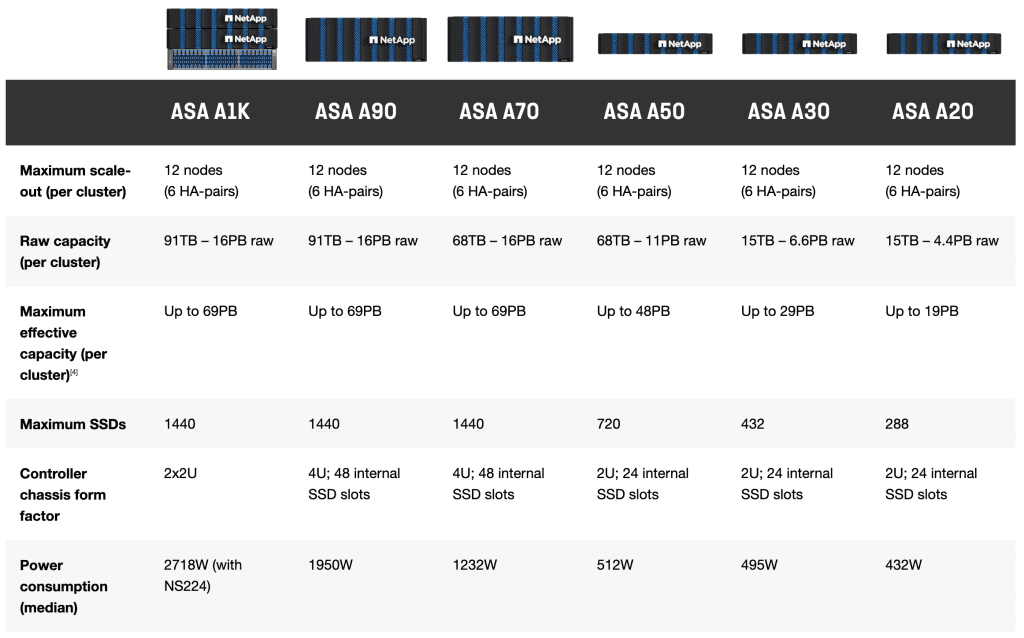NetApp recently announced the expansion of its All-Flash SAN Array (ASA) A-Series systems with three new compact models:
- ASA A20 – Entry-level block storage for smaller deployments, including ROBO and edge locations
- ASA A30 – Optimized for virtualization and mid-tier workloads, offering a balance of performance and efficiency
- ASA A50 – High-performance block storage for business-critical applications, delivering better price/performance than traditional SAN systems
These new models target SMBs with lower price points, starting at $25K.
The A20, A30, and A50 complement the existing ASA A70, A90, and A1K systems, which offer ultra-high performance and sub-millisecond latency for mission-critical workloads, while also achieving significant scale when clustered.

These recently introduced entry-level systems (A20, A30, and A50) are clearly looking at filling a gap in the SMB market, where block-based workloads (primarily VMware and other virtualization platforms) are still predominant, massive scale is not a determining factor (although A20 to A50 systems deliver respectable outcomes), and customers look for balance between performance and affordability.
Another emerging use case identified by NetApp in the high-end finance sector consists of on-premises Kubernetes environments relying on block storage. The ASA A-Series entry-level systems are prized by project teams to deliver cost-effective, high-performance block storage to these dedicated environments.
From a performance perspective, NetApp claims up to 2.7X better performance compared to previous ASA models:
| Model | Performance Gain | Compared To |
|---|---|---|
| A50 | 171% Faster | ASA A400 |
| A30 | 109% Faster | ASA A250 |
| A20 | 72% Faster | ASA A150 |
VMware Cost Savings
NetApp positions ASA as a cost-effective alternative to vSAN-ready nodes, with >70% savings over three years when considering both storage and compute costs.
A-Series systems are not only VMware-compatible but also support Red Hat OpenShift and other virtualization platforms. This is especially relevant as enterprises reconsider Broadcom’s VMware licensing changes and explore alternative hypervisor options.
Simplicity, Availability, & Guarantees
Among key differentiators, NetApp emphasizes “effortless storage operations” by simplifying terminology and volume creation. Storage provisioning takes less than a minute, and workload protection can be enabled with a simple click.
The typical range of NetApp protection options / replication topologies is available with SnapMirror and SnapCenter; built-in application-aware data protection is also supported for workloads such as Oracle DB, Microsoft SQL Server, VMware vSphere and SAP.
In addition, cyber resiliency capabilities are available with SnapLock & tamper-proof snapshots, and NetApp plans to introduce NetApp ONTAP Autonomous Ransomware Protection with artificial intelligence (ARP/AI) for Block later this year, expanding NetApp’s ARP solution to SAN systems.
Lastly, NetApp is also launching the Ransomware Detection Program, an offering that leverages NetApp Professional Services to assist with recovery in case a ransomware attack has not been detected in a timely fashion. This program will initially be available free of charge to customers.

NetApp ASA A-Series includes storage efficiency guarantees, in-place controller upgrades, availability guarantees, and ransomware recovery guarantees.
Some guarantees require professional services validation to ensure compliance with preconditions.
The Osmium Perspective
This announcement is noteworthy for several reasons. Unified storage has been the norm for primary storage, and some vendors now include object storage (S3). At first glance, an exclusive block-storage offering may seem counterintuitive in a world dominated by unified storage. However, this overlooks the fact that most enterprise workloads are block-based, particularly in virtualized environments.
By focusing exclusively on block storage, NetApp reduces complexity and engineering costs, enabling a cost-effective alternative to HCI and unified storage solutions.
At the same time, competing directly against VSAN-ready nodes while supporting other hypervisors places NetApp in an advisory position towards its customers, offering a vendor-agnostic solution and proposing alternate migration paths towards other virtualization platforms, without falling into the lock-in of HCI platforms.
Not only the customers will benefit from NetApp’s proven experience with snapshots, including replication / mirroring capabilities and ransomware protection features, but they will be able to achieve so at compelling price points, especially with the highly cost-effective entry models.



